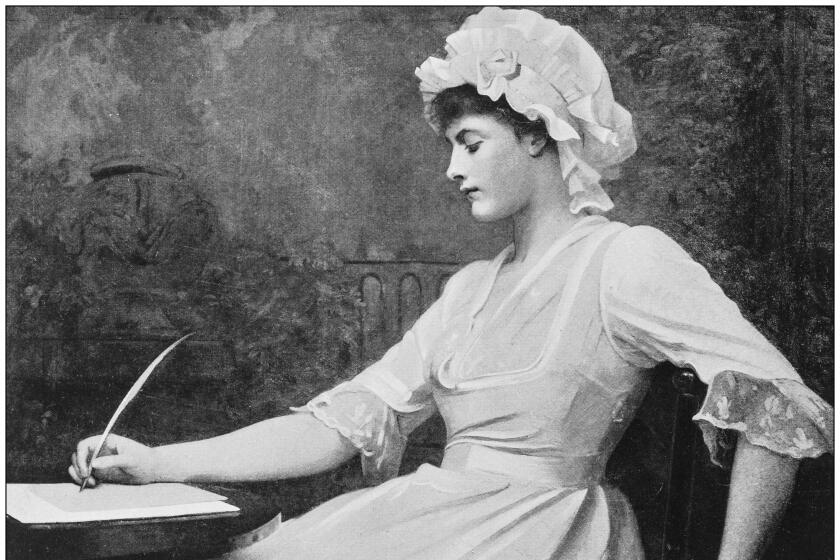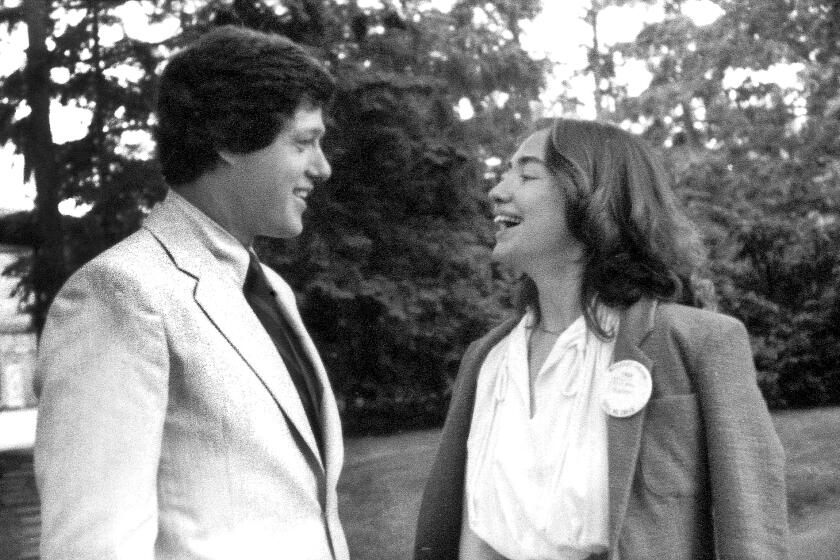Review: Rachel Cusk trades in a blank-slate narrator for a tall drink of vinegar
- Share via
On the Shelf
Second Place
By Rachel Cusk
Farrar, Straus & Giroux: 192 pages, $25
If you buy books linked on our site, The Times may earn a commission from Bookshop.org, whose fees support independent bookstores.
In a 2019 profile of the long-neglected artist Celia Paul, Rachel Cusk mentions a scene from a film about the painter Alberto Giacometti in which he jams dozens of his sketches into a firepit and watches them burn. The consummate swigging, stomping, scolding male virtuoso, Giacometti is performing a role he’ll never be asked to step out of. “The male artist,” Cusk writes, “in our image of him, does everything we are told not to do: He is violent and selfish. He neglects or betrays his friends and family. He smokes, drinks, scandalizes, indulges his lusts and in every way bites the hand that feeds him, all to be unmasked at the end as a peerless genius.”
Artist and male artist are not distinct terms. As Cusk writes in the profile, which finally situated Paul, at 60, as more than Lucien Freud’s nubile muse, female artists have to work through or around or beside their gender. “Of any woman creator, an explanation is required of whether, or how, she dispensed with her femininity and its limitations, with her female biological destiny; of where — so to speak — she buried the body.”
“Second Place,” Cusk’s first novel after the conclusion of her radical, brilliant “Outline” trilogy (“Outline,” “Transit” and “Kudos”), scratches at that variance, popping it open like a fat-domed pimple. Structured as a letter from the narrator, M, to her friend Jeffers, it claims to be an attempt at a portrait of an artist called L — a painter whose work violently rattled M on a long-ago visit to Paris. Alone in the city, without her husband and young child, M was drawn to a gallery where one of L’s self-portraits stared back at her. “Looking at it,” she explains, “I felt myself falling out of the frame I had lived in for years, the frame of human implication in a particular set of circumstances. From that moment, I ceased to be immersed in the story of my own life and became distinct from it.” It so shakes her that after she returns home to England she leaves her husband.
The painter known to many as Lucian Freud’s one-time muse writes of her own muse, her mother, and provers herself a masterful writer as well.
Fifteen years later, remarried and living on the coastal marshes of Norfolk, M invites L, whom she’s never met, to stay at the “second place” behind their house, a cottage of warm wood and lime-washed walls. Other artists have stayed in the past, she explains in a letter, and found the “great but subtle beauty” conducive to working. L comes the following spring.
The visit disappoints M in almost every way. L is an expert in the art of passive cruelty. He won’t paint her because he “can’t really see” her; he avoids her presence and befriends her college-aged daughter in a kind of silent sucker punch; most gallingly, he brings along a bubbly young woman called Brett, a “ravishing creature somewhere in her late twenties.” M recoils. “I had summoned L across the continents intuitively believing that he could perform that transformative function for me, could release me into creative action.” But he won’t. Or can’t.
Cusk is influenced here by a 1922 visit from D.H. Lawrence (whom Cusk has called her “mentor”) to Mabel Dodge Luhan, an arts patroness who coaxed the novelist to New Mexico with promises of inspiring magic coursing through the landscape. Just as M does for L, Mabel laid fires in wait for Lawrence, spruced up the sunny dwelling that backed onto the sacred Taos Mountain and plotted his trip as a chance to absorb some of Lawrence’s potency by osmosis. Mabel considered Lawrence the man “who could understand things for me” — artist as talisman.
Though Lawrence is the inspiration, it isn’t his energy that dominates “Second Place.” Instead I sensed the residue of Anita Brookner’s weary protagonists: bright, cultured women who know what they’re missing out on and resent those who keep it from them. M wonders if reproducing herself — in L’s painting or in her writing (“little books … my own work — if it can be called that”) — will firm her up somehow, smooth out some internal defect. She wants art to save her. In the meantime, she fumes. As Cusk hits all the high notes of indignant rage, this book snaps and steams.
Cusk is still banging up against the same concerns that have animated her work for decades — the compromises of motherhood, the catharsis of travel, how we demarcate our private space. (Sometimes I want to yank her out of that mire, probably because it consumes my work as well.) But the mere existence of “Second Place” makes me wonder if she found the “Outline” trilogy as cleansing as so many of us did.
Novelist Lynn Steger Strong on the revolutionary passivity of Rachel Cusk, Ottessa Moshfegh and Sally Rooney — how we’ve misread them and what comes next.
I also wonder if readers will find “Second Place” less palatable than the trilogy because its protagonist is so much more forceful than Faye. She practically bleats out her complaints, and slashes nearly 130 exclamation points (by my count) into 192 lean pages. Readers love to hate female characters — and Cusk — for causing momentary discomfort, as if reading should be a salve. But in this book more than ever, Cusk is astringent, unsugared. Straight vinegar. It’s delicious and good for the gut.
The trilogy was a gargantuan space, an airy, three-dimensional cathedral. “Second Place” feels like a sketched landscape, a rough draft of ideas old and new that Cusk is gently trying out in narrative form. Rather than feed her efforts to the flames like Giacometti, she packages them. I can imagine this one in a museum, its title card explaining that “Second Place” is how Cusk got from Faye to _____. That’s a compliment, even if it doesn’t seem one; Cusk’s open experimentation is refreshing, as is her belief that a writer must keep moving forward, forging a rough chain.
Cusk has made her reputation by self-consciously interrogating her own bold endeavors, including the “Outline” trilogy, which was partly about the gut renovation of a flat but really (as Judith Thurman put it) a gut renovation of the novel. Here she is figuring out what comes next in a novel that serves as a reality check on the promises of art, including her own.
In 1982 the Atlantic published a “poem” by Williams Carlos Williams’ wife Flossie, a response to his raid on her plums in his famous work “This Is Just to Say …” It begins, “Dear Bill: I’ve made a couple of sandwiches for you./ In the ice-box you’ll find/ blue-berries--a cup of grapefruit/ a glass of cold coffee.” I’ve always loved the zest of Flossie’s reply, how ably she mimics his meter and steals back her image from his work.
“Rodham” is the second novel about a first lady by “Prep” author Curtis Sittenfeld. But it’s the first one to fully rethink history — and Hillary too.
M’s letter-as-novel is such a reply. L invades her home, adulterates it with his grimace, and then turns his canvas in another direction. But his dismissal does ignite something in M after all. He doesn’t paint her, but she writes him.
Kelly’s work has been published in New York Magazine, Vogue, the New York Times Book Review and elsewhere.
More to Read
Sign up for our Book Club newsletter
Get the latest news, events and more from the Los Angeles Times Book Club, and help us get L.A. reading and talking.
You may occasionally receive promotional content from the Los Angeles Times.










